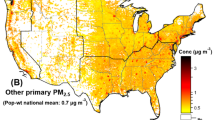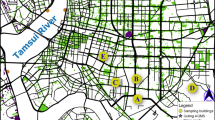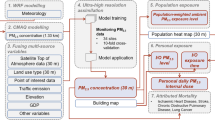Abstract
A novel source-to-dose modeling study of population exposures to fine particulate matter (PM2.5) and ozone (O3) was conducted for urban Philadelphia. The study focused on a 2-week episode, 11–24 July 1999, and employed the new integrated and mechanistically consistent source-to-dose modeling framework of MENTOR/SHEDS (Modeling Environment for Total Risk studies/Stochastic Human Exposure and Dose Simulation). The MENTOR/SHEDS application presented here consists of four components involved in estimating population exposure/dose: (1) calculation of ambient outdoor concentrations using emission-based photochemical modeling, (2) spatiotemporal interpolation for developing census-tract level outdoor concentration fields, (3) calculation of microenvironmental concentrations that match activity patterns of the individuals in the population of each census tract in the study area, and (4) population-based dosimetry modeling. It was found that the 50th percentiles of calculated microenvironmental concentrations of PM2.5 and O3 were significantly correlated with census-tract level outdoor concentrations, respectively. However, while the 95th percentiles of O3 microenvironmental concentrations were strongly correlated with outdoor concentrations, this was not the case for PM2.5. By further examining the modeled estimates of the 24-h aggregated PM2.5 and O3 doses, it was found that indoor PM2.5 sources dominated the contributions to the total PM2.5 doses for the upper 5 percentiles, Environmental Tobacco Smoking (ETS) being the most significant source while O3 doses due to time spent outdoors dominated the contributions to the total O3 doses for the upper 5 percentiles. The MENTOR/SHEDS system presented in this study is capable of estimating intake dose based on activity level and inhalation rate, thus completing the source-to-dose modeling sequence. The MENTOR/SHEDS system also utilizes a consistent basis of source characterization, exposure factors, and human activity patterns in conducting population exposure assessment of multiple co-occurring air pollutants, and this constitutes a primary distinction from previous studies of population exposure assessment, where different exposure factors and activity patterns would be used for different pollutants. Future work will focus on incorporating the effects of commuting patterns on population exposure/dose assessments as well as on extending the MENTOR/SHEDS applications to seasonal/annual studies and to other areas in the U.S.
This is a preview of subscription content, access via your institution
Access options
Subscribe to this journal
Receive 6 print issues and online access
$259.00 per year
only $43.17 per issue
Buy this article
- Purchase on Springer Link
- Instant access to full article PDF
Prices may be subject to local taxes which are calculated during checkout











Similar content being viewed by others
References
Burke J.M., Zufall M.J., and Ozkaynak H. A population exposure model for particulate matter: case study results for PM2.5 in Philadelphia, PA. J Expos Anal Environ Epidemiol 2001: 11: 470–489.
Burmaster D.E., and Crouch E.A.C. Lognormal distributions for body weight as a function of age for males and females in the United States, 1976–1980. Risk Anal 1997: 17: 499–505.
Chandrasekar A., Philbrick C.R., Clark R., Doddridge B., and Georgopoulos P.G. Evaluating the performance of a computationally efficient MM5/CALMET system for developing meteorological inputs to air quality models. Atmos Environ 2003a: 37: 3267–3276.
Chandrasekar A., Philbrick C.R., Clark R., Doddridge B., and Georgopoulos P.G. A large-eddy simulation study of the convective boundary layer over Philadelphia during the 1999 summer NE-OPS campaign3. Environ Fluid Mech 2003b: 3: 305–329.
Chandrasekar A., Philbrick C.R., Doddridge B., Clark R., and Georgopoulos P.G. Evaluation of mesoscale model fifth generation (MM5) applications with NE-OPS 1999 upper air data: a comparative study of MM5 simulations with aircraft, wind profiler, lidar, tethersonde and RASS NE-OPS data over Philadelphia, PA During a 1999 summer episode (final draft). Interim Technical Report CCL-ITR-2001:ORC.NEOPS-01, 2001a.
Chandrasekar A., Philbrick C.R., Doddridge B., Clark R., and Georgopoulos P.G. Evaluation of regional atmospheric modeling system (RAMS) applications with NE-OPS 1999 upper air data: a comparison study of RAMS simulations with aircraft, wind profiler, lidar, tethered balloon and RASS NE-OPS data over Philadelphia, PA during a 1999 summer episode (final draft). Interim Technical Report CCL-ITR-2001:ORC.NEOPS-02, 2001b.
Chandrasekar A., Philbrick C.R., Doddridge B., Clark R., and Georgopoulos P.G. A comparative study of prognostic MM5 meteorological model with aircraft, wind profiler, lidar, tethered balloon and RASS data over Philadelphia during a 1999 summer episode. Environ Fluid Mech 2003c; in press.
Chandrasekar A., Philbrick C.R., Doddridge B., Clark R., and Georgopoulos P.G. An evaluation study of RAMS simulations with aircraft, wind profiler, lidar, tethered balloon and RASS data over Philadelphia during a 1999 summer episode. Atmos Environ 2003d: 37: 4973–4984.
Christakos G. On certain classes of spatiotemporal random fields with applications to space–time data processing. IEEE Trans Systems Man Cybernet 1991: 21: 861–875.
Clench-Aas J., Bartonova A., and Bohler T. Air pollution exposure monitoring and estimating Part I. Integrated air quality monitoring system. J Environ Monit 1999: 1: 313–319.
Douglas S.G., Hudischewskyj A.B., and Gorsevski V. Use of the UAM-V modeling system as an air quality planning tool and for examining heat island reduction strategies. Proceedings of the ACEEE 2000 Summer Study on Energy Efficiency in Buildings. American Council for an Energy Efficient Economy, 2000, pp. 9.83–9.92.
ENVIRON. Users Guide — Comprehensive Air Quality Model With Extensions (CAMx) Version 3.10. ENVIRON International Corp., Novato, CA, 2002.
Freijer J.I., Bloemen H.J.T., de Loos S., Marra M., Rombout P.J.A., Steentjes G.M., and van Veen M.P. Modelling exposure of the Dutch population to air pollution. J Hazard Mater 1998: 61: 107–114.
Gallegos A.F., and Wenzel W.J., HUMTRN: Documentation and Verification for an ICRP-Based Age- and Sex-Specific Human Simulation Model for Radionuclide Dose Assessment, Los Alamos National Laboratory, Los Alamos, NM, 1984.
Georgopoulos P.G., and Lioy P.J. Conceptual and theoretical aspects of human exposure and dose assessment. J Expos Anal Environ Epidemiol 1994: 4: 253–285.
Georgopoulos P.G., and Lioy P.J. MENTOR-based OPERAS (particle exposure and risk analysis systems): an overview. Annual Conference of the International Society of Exposure Analysis, Monterey, CA, 2000.
Georgopoulos P.G., Wang S.W., Vyas V.M., Sun Q., Chandrasekar A., Shade P., Vedantham R., Burke J., McCurdy T., and Özkaynak H. A source-to-dose assessment of population exposures to fine PM, ozone and air toxics in Philadelphia, PA, during a 1999 summer episode. A case study employing MENTOR/SHEDS-1A. Technical Report CERM:2004-01, Prepared for USEPA (Revised Draft submitted for agency review), 2004a.
Georgopoulos P.G., Wang S.W., Yang Y.C., Xue J., Zartarian V., McCurdy T., and Özkaynak H. Assessing multimedia/multipathway exposures to arsenic using a mechanistic source-to-dose modeling framework. Case studies employing MENTOR/SHEDS-4M. Technical Report CERM: 2004-02, Prepared for USEPA (Revised Draft submitted for agency review), 2004b.
Glen G. User's Guide for the APEX3 Model. ManTech Environmental Technology Inc. (prepared for U.S. EPA), Research Triangle Park, NC, 2002.
Grell G.A., Dudhia J., and Stauffer D.R. A description of the fifth-generation Penn State/NCAR mesoscale model (MM5). NCAR Technical Note TN-398 + STR, National Center for Atmospheric Research, Boulder, CO, 1994.
Guinnup D., and Collom B., Telling the OTAG Ozone Story with Data — Final Report, Vol. I, Ozone Transport Assessment Group (OTAG) Air Quality Analysis Workgroup, 1997.
Hayes S.R. Estimating the effect of being indoors on total personal exposure to outdoor air pollution. J Air Pollut Control Assoc 1989: 39: 1453–1461.
Hayes S.R. Use of an indoor air quality model (IAQM) to estimate indoor ozone levels. J Air Waste Manage Assoc 1991: 41: 161–170.
Houyoux M.R., and Vukovich J.M. Updates to the Sparse Matrix Operator Kernel Emissions (SMOKE) Modeling System and Integration with Models-3, The Emission Inventory: Regional Strategies for the Future. Air & Waste Management Association, Raleigh, NC, 1999.
ICRP. Publication 66: Human Respiratory Tract Model for Radiological Protection. Annals of the ICRP Vol. 24/1-3, Oxford, UK, 1994.
ICRP. Publication 72: Age-dependent Doses to the Members of the Public from Intake of Radionuclides: Part 5, Compilation of Ingestion and Inhalation Coefficients. Annals of the ICRP Vol. 26/1, Oxford, UK, 1996.
Johnson T.R., Capel J.E., McCoy M.D., and McCurdy T. Estimation of ozone exposures experienced by urban residents using an enhanced version of PNEM. In: J.J. Vostal (Ed.), Tropospheric Ozone: Critical Issues in the Regulatory Process. Air and Waste Management Association, Pittsburgh PA, 1996, pp. 209–220.
Lee K., Vallarino J., Dumyahn T., Ozkaynak H., and Spengler J.D. Ozone decay rates in residences. J Air Waste Manage Assoc 1999: 49: 1238–1244.
Lioy P.J. The analysis of total human exposure for exposure assessment: a multi-discipline science for examining human contact with contaminants. Environ Sci Technol 1990: 24: 938–945.
Lurmann F., Colome S.D., and Hogo H. Modeling current and future human exposure to ozone in Southern California. In: R.L. Berglund (Ed.), Tropospheric Ozone and the Environment II. Air and Waste Management Association, Pittsburgh, PA, 1992, pp. 725–745.
Lurmann F.W., and Korc M.E. Characterization of human exposure to ozone and PM10 in the San Francisco Bay area. Final Report. STI 93150 1416 FR, Bay Area Air Quality Management District, San Francisco, CA, 1994.
McCurdy T., Geln G., Smith L., and Lakkadi Y. The National Exposure Research Laboratory's consolidated human activity database. J Expos Anal Environ Epidemiol 2000: 10: 566–578.
McCurdy T.R. Human exposure to ambient ozone. In: D.J. McKee (Ed.), Tropospheric Ozone: Human Health and Agricultural Impacts. Lewis Publishers, Boca Raton, FL, 1994, pp. 85–127.
Morris R., Yarwood G., Emery C., and Wilson G. Modeling PM chemistry and PMCAMx update. Presented at Midwest RPO Modeling Meeting. ENVIRON International Corporation, Des Plaines, IL, 2002.
NCAR. PSU/NCAR Mesoscale Modeling System Tutorial Class Notes and User's Guide. National Center for Atmospheric Research, Mesoscale and Microscale Meteorology Division, CO, 1999.
NOAA. National Climatic Data Center Web Site ( http://www.ncdc.noaa.gov/oa/ncdc.html). National Oceanic and Atmospheric Administration, 2003.
Odman M.T., and Ingram C.L. Multiscale Air Quality SImulation Platform (MAQSIP): source code documentation and validation. ENV-96TR002-v1.0, MCNC, Research Triangle Park, NC, 1996.
Ott W.R. Concepts of human exposure to air pollution. Environ Int 1982: 7: 179–196.
Ott W.R. Total human exposure. Environ Sci Technol 1985: 19: 880–885.
Özkaynak H., Xue J., Spengler J., Wallace L., Pellizzari E., and Jenkins P. Personal exposure to airborne particles and metals: results from the Particle TEAM study in Riverside, California. J Expos Anal Environ Epidemiol 1996: 6: 57–78.
Philbrick C.R. Investigations of factors determining the occurrence of ozone and fine particles in Northeastern USA. Proceedings of Symposium on Measurement of Toxic and Related Air Pollutants. Air and Waste Management Association, 1999, pp. 248–260.
Philbrick C.R., Ryan W.F., Clark R.D., Doddridge B.G., Dickerson R.R., Koutrakis P., Allen G., McDow S.R., Rao S.T., Hopke P.K., Eatough D.J., Dasgupta P.K., Tollerud D.J., Georgopoulos P., Kleinman L.I., Daum P., Nunnermacker L., Dennis R., Schere K., McClenny W., Gaffney J., Marley N., Coulter R., Fast J., Doren C., and Mueller P.K. Overview of the NARSTO-NE-OPS program. Proceedings of the Fourth Conference on Atmospheric Chemistry: Urban, Regional, and Global-Scale Impacts of Air Pollutants. American Meteorological Society, Orlando, FL, 2002, pp. 107–114.
Rifai H.S., Hopkins L., and Mehdizadeh F. Developing human exposure estimates for indoor/outdoor air pollution in Houston, Environmental Institute of Houston — 1999 Annual Report. Environmental Institute of Houston, Houston, TX, 2000.
Rosenbaum A. The HAPEM4 User's Guide Hazardous Air Pollutant Exposure Model, Version 4. USEPA Office of Air Quality Planning and Standards, Research Triangle Park, NC, 2002.
Schofield W.N. Predicting basal metabolic rate, new standards, and review of previous work. Hum Nutr Clin Nutr 1985: 39C: 5–41.
Scire J.S., Robe F.R., Fernau M.E., and Yamartino R.J. A User's Guide for the CALMET Meteorological Model (Version 5). Earth Tech, Inc., Concord, MA, 2000.
Serre M., and Christakos G. Modern geostatistics: computational BME in the light of uncertain physical knowledge — the Equus Beds study. Stochast Environ Res Risk Assess 1999: 13: 1–26.
Stockwell W.R., Kirchner F., Kuhn M., and Seefeld S. A new mechanism for regional atmospheric chemistry modeling. J Geophys Res 1997: 102: 25847–25879.
Stockwell W.R., Middleton P., Chang J.S., and Tang X. The second generation regional acid deposition model chenical mechanism for regional air quality modeling. J Geophys Res 1990: 95, 16,343–16,368.
Strum M., Mason R., and Linderman D. User's Guide for the Emissions Modeling System for Hazardous Air Pollutants (EMS-HAP) Version 2.0. EPA 454/B-02-001, U.S. Environmental Protection Agency, Office of Air Quality Planning and Standards, Emissions, Monitoring and Analysis Division, Research Triangle Park, NC, 2002.
Sun Q., Chandrasekar A., and Georgopoulos P.G. Evaluation of models-3/CMAQ with AIRS and NE-OPS data for a 1999 summer episode with focus on New Jersey and the Philadelphia Area (Draft). Technical Report ORC:2002-01, Prepared for the NJ Department of Environmental Protection, 2002.
Sun Q., and Georgopoulos P.G. Comparative evaluation of the performance of the CB4 and RADM2 chemical mechanisms in models-3/CMAQ with focus on the prediction of ozone and PM2.5 levels in New Jersey and the Philadelphia Area. Technical Report ORC:2002-02, Prepared for the NJ Department of Environmental Protection, 2002.
Sun Q., Chandrasekar A., and Georgopoulos P.G. Comparative evaluation of photochemical model predictions using the NE-OPS 1999 field data. Technical Report ORC:2003-01. Ozone Research Center, Piscataway, NJ, 2003.
Turk B.H., Grimsrud D.T., Brown J.T., Geisling-Sobotka K.L., Harrison J., and Prill R.J. Commercial building ventilation rates and particle concentrations. ASHRAE Trans 1989: 95: 422–433.
US Census Bureau. 1990 Census of Population, General Population Characteristics, United States. 1990 CP-1-1, Washingston, DC, 1992.
US Census Bureau. 2000 Census of Population and Housing, Summary Population and Housing Characteristics, United States. PHC-1-1, Washington DC, 2002a.
US Census Bureau. Current Housing Reports, Series H150/01, American Housing Survey for the United States: 2001, US Government Printing Office, Washington DC, 2002b.
USEPA. Final Guidelines for Exposure Assessment. EPA/600Z-92/001, US EPA, National Center for Environmental Assessment, 1992.
USEPA. Exposure Factors Handbook, US EPA, National Center for Environmental Assessment, Cincinnati, OH, 1997.
USEPA. Total Risk Integrated Methodology, TRIM.Expo.: Technical Support Document. EPA-453/D-99-001, USEPA Office of Air Quality Planning and Standards, Office of Air and Radiation, Research Triangle Park, NC, 1999a.
USEPA. User Manual for the EPA Third-Generation Air Quality Modeling System (Models-3 Version 3.0). EPA-600/R-99/055, USEPA, Office of Research and Development, Washington, DC, 1999b.
USEPA. National Air Quality and Emissions Trends Report, 1998. EPA 454/R-00-003, US EPA Office of Air Quality Planning and Standards, Research Triangle Park, NC, 2000.
USEPA. AIRS User's Guide. USEPA Office of Air Quality Planning and Standards, 2001a.
USEPA. Procedures Document for National Emission Inventory, Criteria Air Pollutants 1985–1999. EPA-454/R-01-008, US EPA, Office of Air Quality Planning and Standards, Research Triangle Park, NC, 2001b.
USEPA. User Guide: Air Quality System, USEPA. Office of Air Quality Planning and Standards, Research Triangle Park, NC, 2002.
USEPA. Report on the Model SHEDS-MENTOR-1A ( http://cfpub.epa.gov/crem/crem_report.cfm?deid=75917), USEPA Council for Regulatory Environmental Modeling (CREM), Washington DC, 2004a.
USEPA. Report on the Model SHEDS-MENTOR-4M ( http://cfpub.epa.gov/crem/crem_report.cfm?deid=75918), USEPA Council for Regulatory Environmental Modeling (CREM), Washington DC, 2004b.
Vyas V.M., and Christakos G. Spatiotemporal analysis and mapping of sulfate deposition data over eastern USA. Atmos Environ 1997: 31: 3623–3633.
Walko R.L., and Tremback C.J. RAMS — The Regional Atmospheric Modeling System, Version 4.3/4.4, Introduction to RAMS 4.3/4.4. ASTER Division, Mission Research Corporation, Fort Collins, CO, 2001.
Weschler C.J., Shields H.C., and Nike D.V. Indoor ozone: recent findings. In: R. Burglund (Ed.), Tropospheric Ozone in the Environment II. Air and Waste Management Association, Pittsburgh, PA, 1992, pp. 681–700.
Whitfield R.G., Richmond H.M., and Johnson T.R. Overview of ozone human exposure and health risk analyses used in the US EPA's review of the ozone air quality standard. Proceedings of the Fifth US–Dutch International Symposium on Air Pollution in the 21st Century, ANL/DIS/CP-92660, Noordwijk, The Netherlands, 1997.
Acknowledgements
The support for this work has been provided primarily by the USEPA funded Center for Exposure and Risk Modeling (CERM) at EOHSI (EPAR-827033); and the State of New Jersey Department of Environmental Protection (NJDEP) funded Ozone Research Center (ORC) at EOHSI. Additional funding has been provided by the USEPA funded NorthEast Oxidant and Particle Study (NE-OPS) University Consortium (EPA-TPSU-UMDNJ-826373-14), by EPA STAR Grant No. R826768-01, by the NIEHS Center for Environmental Health Sciences at EOHSI (Grant No. P01 ES11256-01), and by the American Chemistry Council (Grant No. 2488). We thank Professors George Christakos and Mark Serre from the University of North Carolina at Chapel Hill for providing access to the BMELIB software library and for their helpful suggestions in implementing BMELIB programs; and Anatharaman Chandrasekar, Pamela Shade, Srinivas Bandi, Hao-Chen Tan, Yu-Ching Yang and Linda Everett of the Computational Chemodynamics Laboratory for their helpful contributions to this study. We are solely responsible for errors, if any, in the BMELIB results and the accompanying analysis presented in this report.
Author information
Authors and Affiliations
Corresponding author
Rights and permissions
About this article
Cite this article
Georgopoulos, P., Wang, SW., Vyas, V. et al. A source-to-dose assessment of population exposures to fine PM and ozone in Philadelphia, PA, during a summer 1999 episode. J Expo Sci Environ Epidemiol 15, 439–457 (2005). https://doi.org/10.1038/sj.jea.7500422
Received:
Accepted:
Published:
Issue Date:
DOI: https://doi.org/10.1038/sj.jea.7500422
Keywords
This article is cited by
-
Critical assessment and integration of separate lines of evidence for risk assessment of chemical mixtures
Archives of Toxicology (2019)
-
Why local air pollution is more than daily peaks: modelling policies in a city in order to avoid premature deaths
Central European Journal of Operations Research (2018)
-
Probabilistic estimation of residential air exchange rates for population-based human exposure modeling
Journal of Exposure Science & Environmental Epidemiology (2017)
-
Modeling population exposures to silver nanoparticles present in consumer products
Journal of Nanoparticle Research (2014)
-
Modelling of human exposure to air pollution in the urban environment: a GPS-based approach
Environmental Science and Pollution Research (2014)



